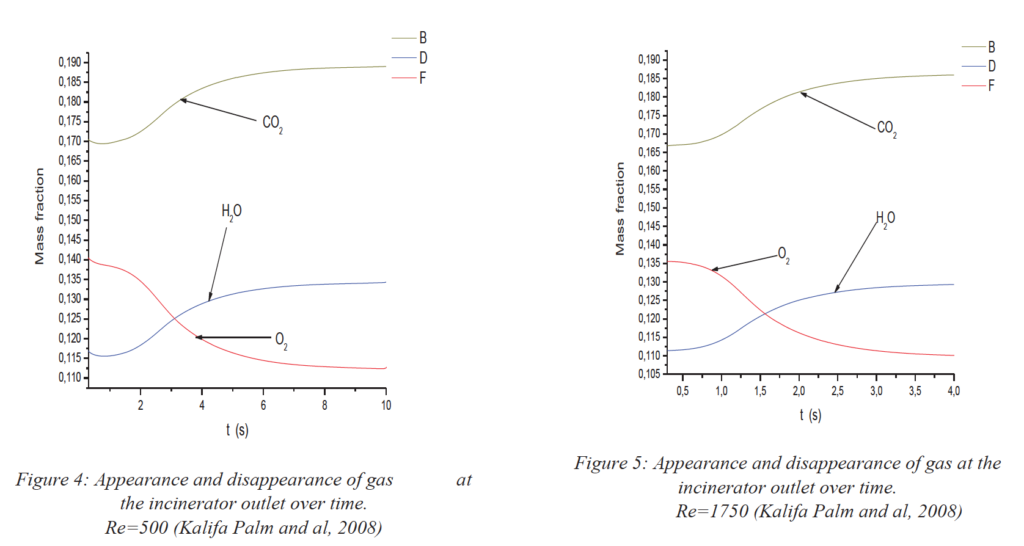Thermal destruction of gas generated from household waste
- Post by: SOAPHYS-KZ
- 16 juin 2021
- Comments off


http://dx.doi.org/10.46411/jpsoaphys.2020.02.15
Section de la parution: Informations de publication
J. P. Soaphys, Vol 2, N°2 (2020) C20A15; 16 Juin 2021
Pages : C20A15-1 à C20A15-5
Information sur les auteurs
Palm Kalifa 1, Lankouandé Roland 2, Ouédraogo Boukaré 2, Sanogo Oumar 1, Chesneau Xavier 3,Zeghmati Belkacem 3
2 Université Norbert ZONGO (UNZ), BP 376 Koudougou, Burkina Faso
3 Université de Perpignan, Laboratoire LAMPS-GME, 52 avenue Paul Alduy, 66860 Perpignan, FranceBadiane Modou 1,*
The burning of industrial, agricultural wastes and garbage into ashes is source of significant air pollution due to the following gas components CO, CO2, CH4, C2H4, H2O… etc. Thermodestruction remains one of the effective technologies used in the depollution of these components. This paper is devoted to the modelling of the thermodestruction in a cylindrical incinerator of gas waste produced by the combustion of garbage. Dimensionless transfer’s equations are solved using an implicit numerical scheme, Thomas and Gauss algorithms. We analyze the influence of the mass rate of the inlet smoke on the effectiveness of depollution.
Keywords : Burning, depollution, effluents, modeling, transfers.
RÉSUMÉ
La combustion des ordures industrielles, agricoles et ménagères avec des cendres est source de pollution atmosphérique significative due aux composants gazeux suivants CO, CO2, CH4, C2H4, H2O etc. La thermodestruction des gaz reste l’une des techniques les plus efficaces utilisées pour la dépollution de ces composants gazeux. Cette étude est consacrée à la modélisation de la thermodestruction dans un incinérateur cylindrique de gaz produits par la combustion des ordures ménagères. Les équations de transferts sont adimensionnalisées et résolues en utilisant une méthode numérique implicite, les algorithmes de Thomas et de Gauss. Nous analysons l’influence du débit de la
fumée d’admission sur l’efficacité de la dépollution.
Mots-Clés: Combustion, depollution, effluents, modélisation, transfert
Bahillo A., Armesto L., Cabanaillas A., Otero J. Thermal valorization of footwear leather wastes in
bubbling fluidized bed combustion. Waste Management, 24 (2004), p 935-944. https://doi.org/10.1016/j.wasman.2004.07.006
Bergeron C.A., Hallet W.L.H. (1989). Autoignition of single droplets of two-component liquid fuels. Combustion Science and Technology (1989) 65, p181-194. https://doi.org/10.1080/00102208908924048
Euvrard D. (1994). Résolution numérique des équations aux dérivées partielles. Edition Dunod, 3ème édition, 1994.
Kalifa Palm, Issaka Ouédraogo, Alioune Ouédraogo, Xavier Chesneau, Belkacem Zeghmati. (2008). Modélisation des Transferts de Chaleur et de Masse d’un Écoulement Laminaire Réactif dans une Enceinte Cylindrique. Journal de la Société Ouest-Africaine de Chimie (2008) 026, pp 26-40 http://www.soachim.org/index.php/fr/sommaire?start=20
Gordon McKay. (2002). Dioxin characterisation, formation and minimisation during municipal solid waste (MSW) incineration: review. Chemical Engineering Journal (2002) 86, p 343-368. https://doi.org/10.1016/S1385-8947(01)00228-5
Kulasekaran S., Linjewile T.M., Agarwal P.K. (1999). Mathematical modelling of fluidized bed combustion 3. Simultaneous combustion of char and combustible gases. Fuel (1999) 78, p 403-417. https://doi.org/10.1016/S0016-2361(98)00163-X
Nammari D. R.N., Hogland W., Marques M., Nimmermark S., Moutavtchi V. (1998). Emissions from a controlled fire in a municipal solid waste bales. Waste Management (2004) 24, p 9-18. https://doi.org/10.1016/j.wasman.2004.07.006
Olsommer B., Dupreux Y., Von Sparkovsky M., Van Gilst J. (1997) Simulation numérique d’un four d’incinération d’ordures industriel couplé à une chaudière à circulation naturelle. Revue Générale de Thermique (1997) 36, p135-148. https://doi.org/10.1016/S0035-3159(99)80058-0
Oturan M.A., Robert M. (1997). Thermodynamique chimique. Presses Universitaires de Grenoble, 1997
Saatdjian E. (1998). Phénomènes de transport et leurs résolutions numériques. Polytechnica, 1998


